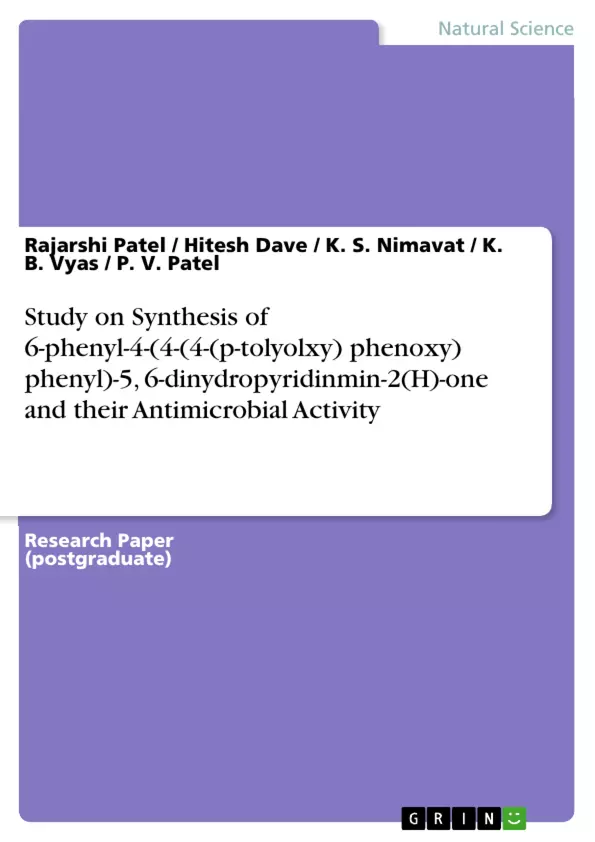1-chloro-4-(p-tolyolxy)benzene react with 1-(4-hydrogy phenyl)-ethanone in presence of copper metal as a catalyst gives 1-(4-(4(p-tolyolxy) phenoxy)phenyl )ethanone,this derivatives react with various substituted aldehyde to give corresponding substituted chalcone derivatives (N-1).Now these derivatives(N-1).on condensation with used gives 6-phenyl-4(4-(4-(p-tolyolxy) phenoxy) phenyl)-5,6-dinydropyridinmin-2(H)-one (N-2) Structure elucidation of synthesized. Compound has been made on the basis of element analysis, 1H NMR Spectra studies.
The microbial activity of the synthesized compounds has been studied against the species bacillus subtillis, staphylococcus aureus, Escherichia coli, and salmonella typhi.
Inhaltsverzeichnis (Table of Contents)
- ABSTRACT
- Keywords
- INTRODUCTION
- REACTION SCHEME
- EXPERIMENTAL
- (1) Preparation of 1-(4-(4-(p-tolyloxy)phenoxy)phenyl)ethanone
- (2) Preparation of (E) -3-Phenyl-1-(4-(4-(p-tolyloxy) phenoxy)phenyl)prop-2-en-1-one
- (3) Preparation of 6-phenyl-4-(4-(4-(p-tolyloxy)phenyl)-5-6-dihyhropyrimidin-2(1H)-One
- RESULTS AND DISCUSSIONS
- Melting points
- Antimicrobial activity
- ANALYSIS DATA
Zielsetzung und Themenschwerpunkte (Objectives and Key Themes)
This research paper focuses on the synthesis and antimicrobial activity of 6-phenyl-4-(4-(4-(p-tolyloxy) phenoxy) phenyl)-5, 6-dihydropyrimidin-2(1H)-one derivatives. The research aims to explore the potential of these compounds as antimicrobial agents.
- Synthesis of substituted chalcone derivatives and their transformation into pyrimidine derivatives.
- Structural elucidation of the synthesized compounds through elemental analysis and spectroscopic techniques (NMR).
- Evaluation of the antimicrobial activity of the synthesized compounds against bacterial and fungal species.
- Exploration of the relationship between the structural modifications and the antimicrobial properties of the compounds.
Zusammenfassung der Kapitel (Chapter Summaries)
The introductory section of the research paper provides background information on chalcones and pyrimidines, highlighting their biological significance and medicinal applications. The research objective is then introduced, outlining the synthesis and evaluation of novel pyrimidine derivatives for their antimicrobial potential.
The experimental section describes the detailed procedures for the synthesis of the target compounds. It outlines the steps involved in the preparation of 1-(4-(4-(p-tolyloxy)phenoxy)phenyl)ethanone, (E)-3-Phenyl-1-(4-(4-(p-tolyloxy) phenoxy)phenyl)prop-2-en-1-one, and the final pyrimidine derivatives.
The results and discussions section presents the characterization data of the synthesized compounds, including their melting points, spectroscopic data, and elemental analysis. The antimicrobial activity of the compounds is then discussed, highlighting their effectiveness against specific bacterial and fungal species.
Schlüsselwörter (Keywords)
The study focuses on the synthesis of heterocyclic compounds, specifically chalcone derivatives and pyrimidine derivatives. It explores their antimicrobial properties, particularly against bacteria such as Staphylococcus aureus and Escherichia coli, and fungi such as Candida albicans. The research emphasizes the potential of these compounds for developing new antimicrobial agents.
- Quote paper
- Dr. Rajarshi Patel (Author), Hitesh Dave (Author), K. S. Nimavat (Author), K. B. Vyas (Author), P. V. Patel (Author), 2013, Study on Synthesis of 6-phenyl-4-(4-(4-(p-tolyolxy) phenoxy) phenyl)-5, 6-dinydropyridinmin-2(H)-one and their Antimicrobial Activity, Munich, GRIN Verlag, https://www.grin.com/document/207809



